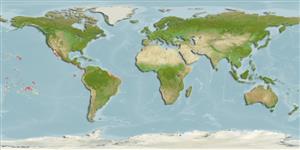Rhinella marina (Linnaeus, 1758)
Marine toad| Native range | All suitable habitat | Point map | Year 2050 |

|
| This map was computer-generated and has not yet been reviewed. |
| Rhinella marina AquaMaps Data sources: GBIF OBIS |
Upload your photos
Google image |
No photo available for this species.No drawings available for Bufonidae.
Google image |
No photo available for this species.
Classification / Names Common names | Synonyms | CoL | ITIS | WoRMS
Amphibia | Anura | Bufonidae
Environment: milieu / climate zone / depth range / distribution range Ecology
Others; freshwater; brackish. Tropical
Distribution Countries | FAO areas | Ecosystems | Occurrences | Introductions
Pacific and Atlantic: South and Central America.
Length at first maturity / Size / Weight / Age
Maturity: Lm ? range ? - ? cm Max length : 23.0 cm TL male/unsexed; (Ref. 86255)
Adults range from 15 to 23 cm in length. This species has a bufotoxin that is a defense mechanism for marine toads. This causes irritation to humans and animals especially when in contact with the eyes and other mucous membranes (Ref. 86255). This is an omnivorous species. Its diet is composed of insects like beetles, ants, and earwigs, vegetation, small birds, other amphibians like toads, frogs, lizards, small mammals and snakes (Ref. 86255).
Life cycle and mating behavior Maturity | Reproduction | Spawning | Eggs | Fecundity | Larvae
Mating season is during spring, particularly late March. Breeding is from April to September wherein two strings of eggs are released by the female on the water surface. It takes 3 days before hatching occurs. From small tadpoles, they metamorphose to small toads in 45 to 50 days.
Main reference
References | Coordinator | Collaborators
Integrated Taxonomic Information System. 2003. (Ref. 538)
IUCN Red List Status (Ref. 130435)
CITES status (Ref. 108899)
Not Evaluated
CMS (Ref. 116361)
Not Evaluated
Threat to humans
Other
Human uses
| FishSource |
Tools
More information
Internet sources
BHL | BOLD Systems | CISTI | DiscoverLife | FAO(Publication : search) | Fishipedia | GenBank (genome, nucleotide) | GloBI | Gomexsi | Google Books | Google Scholar | Google | PubMed | Tree of Life | Wikipedia (Go, Search) | Zoological Record
Estimates based on models
Preferred temperature
(Ref. 115969): 24.2 - 29.1, mean 27.7 (based on 264 cells).


